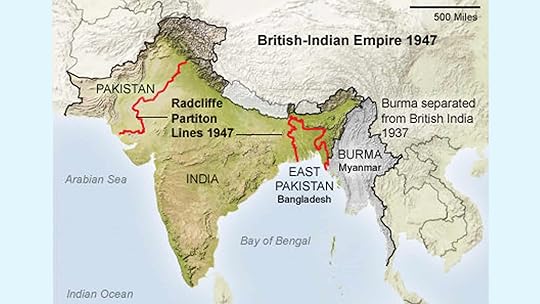The Partition of India in 1947

Episode 31 The 1947 Partition
A History of India
Michael Fisher (2016)
Film Review
The 1947 partition of India and Pakistan left millions of refugees in hostile territories where their ancestors had resided for centuries.
During World War II, the British imprisoned the most prominent (and most moderate) nationalists Gandhi and Nehru, which significantly empowered both left wing and right wing nationalists. The Communist Party of India (at the direction of Stalin) initially supported Hitler but switched sides following Hitler’s invasion of the Soviet Union. In 1942, leftist nationalists led multiple uprisings destroying post offices, police stations and other government facilities. Most of these were put down by British troops stationed in India as a staging area.
Former prime minister Winston Churchill is accused of engineering a famine in Bengal (India’s nationalist stronghold) in 1943, in hopes of furthering weakening India’s independence movement. As the Japanese invaded western India from Burma, he ordered all grain and boats confiscated in their path. As he redirected the confiscated grain to Bengal cities and British troops, three million rural Bengali were left to die.
Meanwhile right wing Muslim principalities (who had strong allies in the British House of Lords) did their best to suppress uprisings. While right wing Hindu principalities mobilized popular uprisings demanding an independent Hindu India.
In 1933, Cambridge student Choudhry Rami Ali first proposed the name Pakistan for a separate Muslim nation in India. Its literal meaning is “land of purity,” although it’s also an acronym for the Muslim majority provinces Muslim activists proposed to incorporate into the new nation of Pakistan: Punjab, Afgania, Kashmir, Sindh and Balochistan.
As spokesman for the Muslim League, Muhammad Ali Jinnah wanted the entire Muslim majority provinces of Punjab and Bengal as part of Pakistan, even though they had large Hindu and Sikh minorities. The British and the Indian National Congress would only agree to contiguous Muslim majority regions joining Pakistan, which left about half of Bengal and Punjab in India.
Churchill’s defeat by Clement Atlee in 1945 was viewed as support for decolonization. Hoping to bolster partition negotiations, Jinnah called a day of Direct Action in August 1946 in which 10,000 people were killed.
Sir Cyril Radcliffe was appointed to determine the final boundaries between India and Pakistan, which weren’t announced until after independence.
The sectarian fighting between Muslim and Hindu activists went on for months. West Pakistan, which was 97% Muslim, drove out 5 million Hindus and Sikhs with nothing but what they could carry.
Sectarian fighting drove a comparable number of Muslims out of India, though an equal number remained.
Gandhi went on hunger strike until the treasury of newly independent India allocated gave an appropriate share of its pre-partition monies to Pakistan.
Film can be viewed free with a library card on Kanopy.
https://www.kanopy.com/en/pukeariki/watch/video/366254/366231
The Most Revolutionary Act
- Stuart Jeanne Bramhall's profile
- 11 followers



